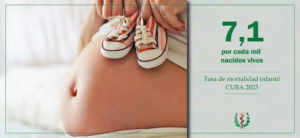 Havana, Cuba.- Cuba’s infant mortality rate dropped in 2023 to 7.1 per 1,000 live births, a palpable result of the efforts of more than 400,000 workers in the sector, the Ministry of Public Health, Minsap, reported Wednesday.
Havana, Cuba.- Cuba’s infant mortality rate dropped in 2023 to 7.1 per 1,000 live births, a palpable result of the efforts of more than 400,000 workers in the sector, the Ministry of Public Health, Minsap, reported Wednesday.
According to the note published by that ministry, what may seem more than just figures, data and flat statistics, sums up the dedication and devotion of those who, in their daily work, bring smiles and hopes to Cuban families.
They are hours, days and long nights of sacrifice, medical guards, specialized consultations, community and intersectoral work, home visits and accompaniment to mothers, among other permanent protocols of the Minsap, the text specifies.
“When the world shows alarming and sad figures, even in developed countries, this decrease in infant deaths in Cuba is a gift to the people, because it is about lives saved, about defending the most precious thing that a human being has, and much more if it is about newborns,” the note stresses.
The national head of the Maternal and Infant Program (PAMI), Catherine Chibás, indicated that there are 74 fewer deaths than in 2022, when a rate of 7.5 was reported.
She added that six provinces reached numbers below the country’s average, where the best indicators correspond to Pinar del Río with 3.1; Artemisa with 3.9; Holguín with 4.7; Sancti Spíritus with 4.8; Villa Clara with 5.7 and Matanzas with 6.9″.
In this regard, he stressed that last year 25 municipalities reported no deaths of children under one year of age, while insisting on the human importance of these parameters for both Cuban families and all health personnel in a complex and challenging stage for all.
According to preliminary data, 90,374 live births were reported at the end of the year, and a decrease in the preschool mortality rate, from 4.1 to 3.6 per 10,000 inhabitants, with 35 fewer deaths in this age group.
The school-age mortality rate also decreased from 2.4 to 2.1 per 10,000 inhabitants, representing 28 fewer deaths than in the previous year.
Another important fact was the decrease in the infant mortality rate due to congenital defects, which dropped from 1.0 per 1,000 live births at the end of 2022 to 0.7 in the year just ended, which is the lowest recorded for congenital malformations in Cuba and the best indicator of its kind in the Americas, the specialist highlighted.
It stands out in the assessment how in the last eight years the rate of mother-to-child transmission of HIV has been equal or lower than two percent, and the conditions that accredited Cuba as the first country to eliminate mother-to-child transmission of HIV-AIDS and syphilis in the region are maintained